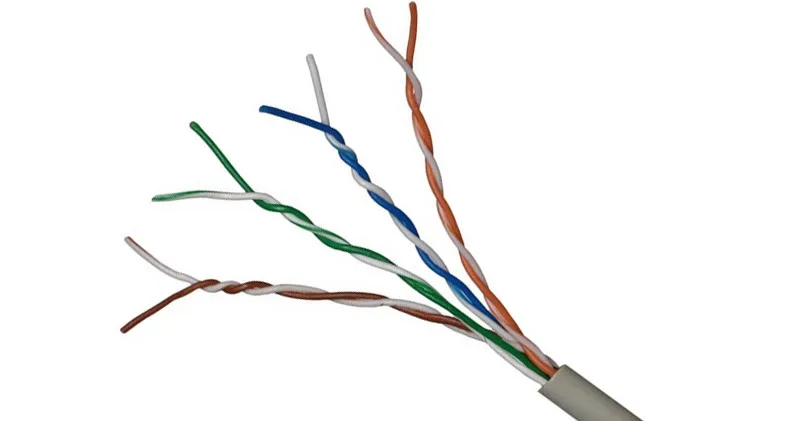What is a Twisted Pair Cable?
The twisted pair is the frequently used transmission medium in the Generic Cabling System Project. It consists of two copper wires with insulating protective layers. These two insulated copper wires are twisted together to reduce electromagnetic radiation and resist external interference. The radio wave radiated by one of the wires will be canceled by the radio wave emitted by the other wire.

Twisted Pair Cable Diagram
A twisted pair cabling system consists of one or more copper twisted pairs. Different twisted pairs have different twist lengths. Generally, the twist length is between 38.1~14cm. The twisting length of adjacent pairs is beyond 12.7cm. Each copper wire is twisted counterclockwise.
Compared with other transmission media, such as optical fiber cable, twisted pair wire is limited in transmission distance, channel width, and data transmission speed, but the price is relatively low.
Types of Twisted Pair Cables: UTP and STP
There are two types of twisted pair cables, shielded twisted pair (STP) and unshielded twisted pair (UTP).

UTP vs STP
Shielded Twisted Pair (STP):
Compared with UTP, STP has an extra insulation layer in the form of aluminum foil and copper braid mesh.
Advantages of STP:
• Aluminum foil outer layer helps reduce electromagnetic radiation.
• Support higher data rate and bandwidth than UTP.
Disadvantages of STP:
• Price is relatively higher than UTP.
• Installation is more difficult than UTP. Similar to coaxial cable, it must be equipped with specific connectors supporting shielding function and professional installation skills.
Application of STP:
Shielded twisted pair (STP) cabling is often used for high-efficiency information transmission. Compared with the unshielded twisted pair (UTP), it provides higher transmission performance. It is often applied in an environment with large interference or harsh electromagnetic requirements.
Unshielded Twisted Pair (UTP):
Without any metal shielding layer, only covered by an insulating rubber.
Advantages of UTP:
• Space saving without any shielding layer and small diameter.
• Easy installation with light weight.
• High flexibility, suitable for the structured generic cabling system.
• Low cost.
Disadvantages of UTP:
• UTP link is not as secure as STP link.
• Only accepts distances up to 100 meters. When distances are beyond 100m, it must be installed in sections.
• It has limited bandwidth and data rate.
Application of UTP:
Unshielded twisted pair (UTP) cabling is more commonly used in most local area networks (LANs) because of its advantages of cost-effectivity, high flexibility, and easy installation and maintenance. The twisted pair ethernet cable comprises a certain length of twisted pair and RJ45 crystal.
Twisted Pair Cable Category
Cat1: 750 kHz bandwidth, only allows voice transmission, does not support data transmission, mainly used in telephone cables before the 1980s.
Cat2: 1 MHz bandwidth, allows voice transmission and data transmission within 4Mbps data rate, mainly used in token ring networks.
Cat3: 16 MHz bandwidth, described in EIA/TIA-568, allows voice transmission and data transmission within a 10Mbps data rate. The typical application is 10BASE-T.
Cat4: 20 MHz bandwidth, 16Mbps data rate, mainly used in LANs based on the token ring and 10/100BASE-T. Not commonly used.
Cat5: 100 MHz bandwidth, supports 100Mbps data rate based on increased twisting density and high-quality insulating jacket. The typical application is 100BASE-T and 1000BASE-T, reaching up to 100m.
Cat5e: lower attenuation and crosstalk than Cat5, better signal-to-noise ratio (SNR), and smaller delay error, mainly used in 1000BASE-T.
Cat6: 250 MHz bandwidth, supports 10Gbps data rate, improved performance in crosstalk and return loss, mainly used in 1000BASE-T (reaching up to 100m) and 10GBASE-T (reaching up to 55m).
Cat6a: 500 MHz bandwidth, supports 10Gbps data rate, improved alien crosstalk, mainly used in 10GBASE-T, reaching up to 100m.
Cat7: 600 MHz bandwidth, improved EMI and crosstalk protection, using GG45 or TERA connectors.
FAQs About Twisted Pair Cable
Q: Why are wires twisted together in twisted pair cables?
A: Copper wires twisted together is helpful for reducing electromagnetic radiation and resisting external interference. The twisted way also helps limit interference with adjacent twisted-pair cables, the radio wave radiated by one of the wires will be canceled by the radio wave emitted by the adjacent wire.
Q: What are the two types of twisted pair cables?
A: Unshielded twisted pair (UTP) and Shielded twisted pair (STP). STP has an extra aluminum foil insulation layer while UTP doesn’t.
Q: What is twisted pair cable used for?
A: Twisted pair cable is mainly used to transmit analog voice information and short-range digital data information. The use cases for twisted pair copper cabling include telephone lines, DSL lines, and local area networks (LANs)
Q: Which connector is used with unshielded twisted pair (UTP) cable?
A: RJ45 connector is the standard connector for unshielded twisted pair cabling.
Q: What is shielded twisted pair cable used for?
A: Shielded twisted pair cable has an extra insulation layer to reduce crosstalk and electromagnetic interference (EMI). It is usually used in environments with large interference or harsh electromagnetic requirements.









